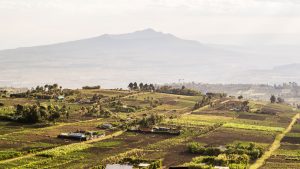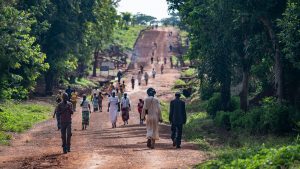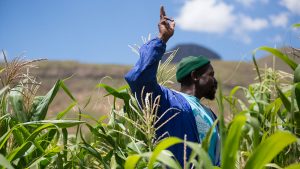Bill Rettie recalls some of the lessons he learned during the fourteen years he spent working with the church in Kenya establishing a project that fully integrates the gospel and development.
The view over the southern Kerio Valley was spectacular. From the steep escarpment down to the broad valley floor, acacia trees extended as far as the eye could see. Everything there seemed peaceful and unspoiled.
That first descent into the valley in June of 1986 was a stark reminder that first impressions usually don’t tell the whole story. The community living there was still reeling from the effects of yet another drought and famine. The signs of malnutrition and associated ailments were evident in both the people and the few livestock which had survived. Perhaps even more striking was the pervading sense of discouragement and acceptance – this was how life was in the Kerio valley. Invited by the Africa Inland Church and assigned here by Aim to initiate a church-based development programme, the magnitude of the challenge was not lost on me. Where do you begin, what can you do? The words of Jesus often came to mind in these early days, “I have come that they may have life, and have it to the full” (John 10:10). Great words, a tremendous promise but what did it mean in this situation, at this time? What was our responsibility in seeing that promise become reality in the southern Kerio Valley? It was the beginning of a exciting, yet at times very humbling, learning experience.
You never walk alone
The first lesson was that of partnership with the local community and church. We needed to work together if change was to happen. A fifty-acre area of land had been given by the local community to the church to start a development programme. After long hours of discussion involving the whole community, the proposal to establish a demonstration and training farm was worked out and agreed.
How do you build a traditional mud-walled house to get started? Western training doesn’t help here but for local people it presented few problems. Where do you find a reliable source of water? This was a challenge to everyone in this semi-arid area where the women could walk for two or more hours to collect water in the dry season. However the sources of water at any time is part of local knowledge and so a suitable source was identified by the wazee (village elders), with the added assurance that it would not run dry. In twenty years it never has. Soon to be piped down to where it was most needed, this water, the fruit of a partnership between the church and community, was the beginning of many changes in that area. Local wisdom was not always infallible however. Bringing European dairy cows into the area for the first time earned the earnest advice, “These animals are like you wazungu (white people), very delicate and not able to live in these harsh conditions.” They did and still do, in increasing numbers. So the programme was established and began to impact the neighbouring communities.
People who were more accustomed to waiting for famine relief were now developing their own farms
Being involved with local people in their daily lives gave many opportunities to explain the good news of the gospel. Local Christians, some of whom were now working on the project eagerly used these opportunities in farm visits, schools, youth camps and wherever the opportunity arose. Slowly at first, but with gathering momentum, the impact of the work spread through the community. People who were more accustomed to waiting for famine relief were now developing their own farms. Vegetables, fruit, cereals and improved livestock began to appear and an area once dependent on outside help began to send produce to other areas. Significantly many of those who took a lead in this transformation were those who had come to faith in Christ and were living out that faith not only in the growing churches but in their lives within the community too.
The plan is bigger than you think
It would be easy and tempting to assume that this transformation process began with the programme in the 1980s. That was far from the truth. In many conversations the name of one Margaret Armstrong was often mentioned with great respect. Margaret, an Aim missionary from Northern Ireland used to visit the area in the 1960’s. She was probably the first white missionary to stay in the area for any length of time. That in itself impressed her hosts -“she ate our food”. More importantly she brought the gospel and talked to whoever would listen. There was little evident response at that time but Margaret prayed fervently that the Lord would establish his church in that place. She returned home to Ireland and subsequently died without ever seeing an answer to her prayer. Yet today there is not one but six Africa Inland Church (AIC) congregations in this area plus a number of other denominations. It is estimated that over half of the whole community regularly worship in these churches. A recently completed church building will have a commemorative plaque to Margaret’s memory – a fitting tribute to one who planted for others to reap.
A future and a hope
The immense problems facing Africa can often seem overwhelming to national and expatriate alike. In that the Kerio Valley is no exception. There are setbacks, disappointments and challenges – life in a semi-arid rural community is never easy.
Yet in this small corner of the continent there are signs of hope. There is a new spirit of optimism as local people take charge of their own situation and rely much less on help from outside.
From small beginnings the development programme has grown from a demonstration farm into a thriving Training and Conference Centre. There are no missionaries serving in the area now. Their work has been taken up and expanded by committed national believers.
Groups come to the centre from many different parts of Kenya for courses in agriculture, livestock, water development, church leadership, preaching and teaching. Regardless of the subject, the word of God is always faithfully presented by the project chaplain, who is himself a local man.
The southern Kerio Valley is still stunningly beautiful. That beauty still hides great needs and hardship, but increasingly it surrounds a people who, through the transforming power of the gospel, are experiencing something of the reality of living with a future and a hope.



